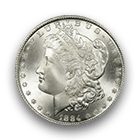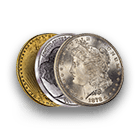The 1916-D Mercury Dime is one of the most sought-after rarities of the 20th century, and yet its story had humble beginnings. The issue, and its entire series, marked a mid-year transition from the long-running Barber Dime that had launched in 1892. The Mercury Dime, originally and formally known as the Winged Liberty Head Dime, was designed by Adolph A. Weinman and was a hit with the public. Yet, not many people were collecting contemporary United States coinage, though there was interest in the first-year release of the new Mercury Dime. However, the vast majority of the 1916 Mercury Dimes being saved as mementos were from the “Mother Mint” in Philadelphia – not the branch mints. And that’s where the story of the 1916-D Mercury Dime and its rarity comes in.
The Denver Mint produced only 264,000 Mercury Dimes in 1916. Numismatic author Walter Breen posited that Denver production of Mercury Dimes was supplanted by production of the quarter. This rendered what became the lowest mintage for any circulation-strike Mercury Dime. One might think that news of the 1916-D Mercury Dime’s low mintage would have reached collectors, but the reality is this information wasn’t widely broadcast, and few collectors were seeking modern Denver strikes anyway.
It wasn’t until decades later that the American public, certainly the plurality of numismatists, really understood how challenging 1916-D Mercury Dimes were in the context of U.S. coin production. In the 1930s and ‘40s, the advent of the coin board, used for building sets of contemporary U.S. coins from pocket change and other circulation channels, brought to notice the relative scarcity of many 20th-century coins, including the 1916-D Mercury Dime. By the mid-20th century, only a fraction of the 1916-D Mercury Dimes that had been struck were still in desirable condition. The demand for that key-date coin ran high, sending prices for the coin skyrocketing.
Today, the 1916-D Mercury Dime holds a cherished spot in the American numismatic canon, sharing pedestal space also claimed by the likes of the 1909-S VDB Lincoln Cent and 1916 Standing Liberty Quarter. PCGS estimates some 10,000 survivors across all grades, with the majority known in circulated condition. Examples of the 1916-D Mercury Dime in G4 currently retail for around $1,500, with specimens in F12 taking $3,750 and those in XF40 going for $8,500. Uncirculated representatives are far tougher still to locate. PCGS estimates perhaps 700 survivors in MS60 or better, with most of those – about 600 – believed to rank as Full Bands (FB) examples.
A basic MS63 garners around $22,500, while an MS64FB can fetch some $37,500. Clearly, any 1916-D Mercury Dime is a highly sought-after and desirable coin, and there are many opportunities to include one in a PCGS Registry Set. There are a terrifying number of counterfeits and altered pieces floating around out there that are designed to look like 1916-D Mercury Dimes. Therefore, it behooves you to purchase only PCGS-graded examples to ensure your protection and the integrity of your collection.







 Copper & Nickel
Copper & Nickel
 Silver Coins
Silver Coins
 Gold Coins
Gold Coins
 Commemoratives
Commemoratives
 Others
Others
 Bullion
Bullion
 World
World
 Coin Market
Coin Market
 Auctions
Auctions
 Coin Collecting
Coin Collecting
 PCGS News
PCGS News